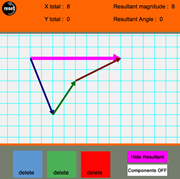Physics Interactives on the Physics Classroom Online Tutorial
 Vector Addition
Vector Addition
Drag a vector onto the canvas. Drag the arrowhead to change its direction. Repeat up to two more times and guess the direction of the resultant. Click/tap a button and the resultant is drawn. Don't we all wish that adding vectors was that easy. With the Vector Guessing Game Interactive, a learner can improve their understanding and skill at adding vectors using the head-to-tail method.
- Shockwave Studio on the Physics Classroom Online Tutorial
- Practice your skill at constructing free-body diagrams for a given physical situation. Twelve different descriptions of a physical situation are presented; your goal is to determine the type and relative magnitude of the forces acting upon the described object.